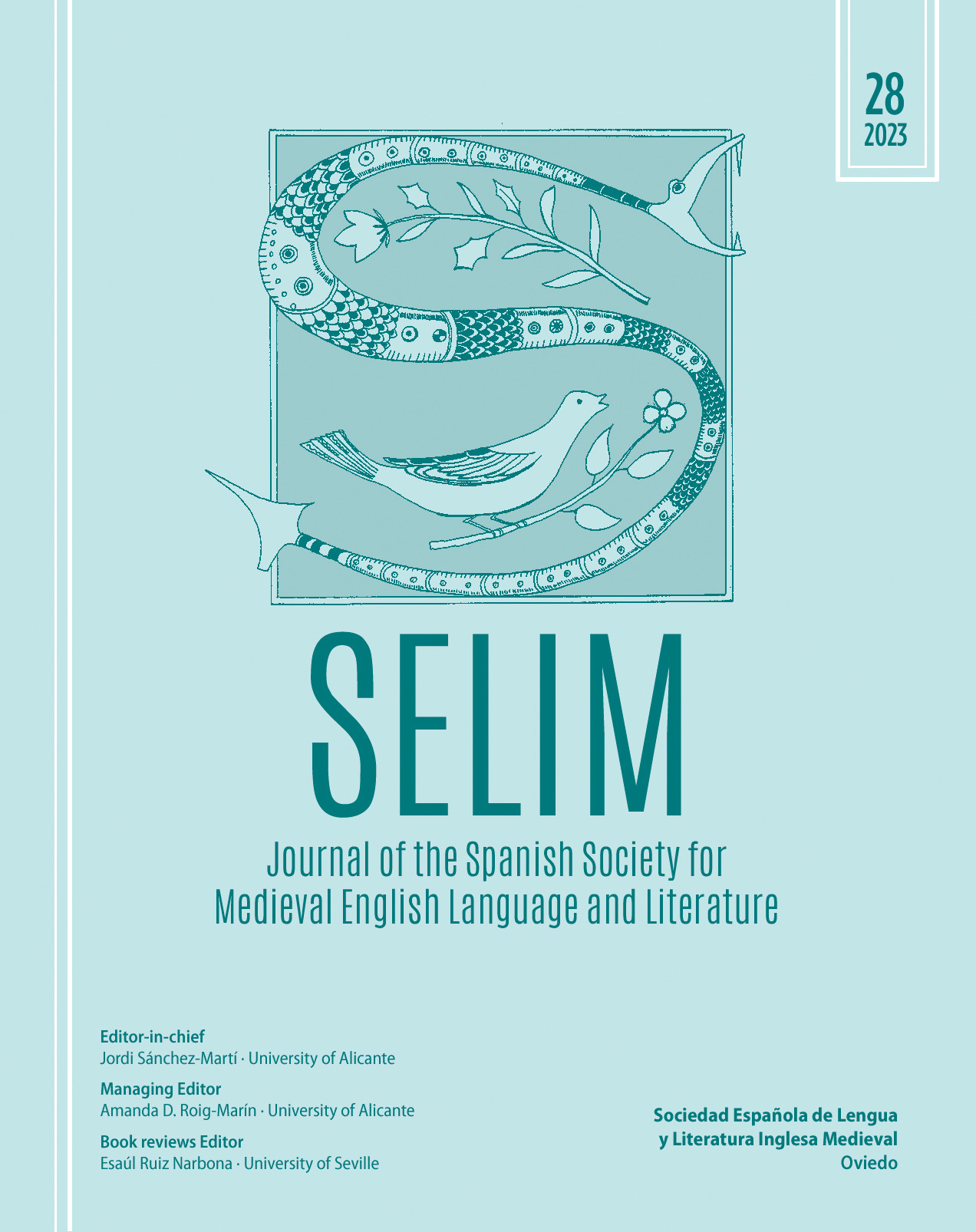Abstract
This paper focuses on the inflections of Latin feminine names in Old English. Whereas most Latin loanwords are perfectly integrated and behave like Old English words as far as their morphology is concerned, like scientific loans, names can take inflectional endings from both Latin and Old English. Ruiz Narbona (2023) has shown that, in the case of masculine names, the distribution of both types of inflections followed certain clear patterns. Following the model of that study, the analysis of the 125 tokens from the Old English Martyrology shows that certain rules can also be established in the case of feminine names. In general terms, the inflections of these names are modelled after Old English weak n-stems, although nominative inflections are invariably Latin. The case with the more widespread variation is the genitive, where both Old English and Latin inflections are consistently used. The latter, however, are heavily restricted to introductory sections and function solely as post-modifiers.
References
Baker, Peter S. 1998. “The Inflection of Latin Nouns in Old English Texts.” In Words and Works: Studies in Medieval English Language and Literature in Honour of Fred C. Robinson, edited by Peter S. Baker, and Nicholas Howe, 187–206. Toronto: University of Toronto Press.
Brunner, Karl. 1965. Altenglische Grammatik nach der angelsächsischen Grammatik von Eduard Sievers (3rd edition). Tübingen: Niemeyer.
Campbell, Alistair. 1959. Old English Grammar. Oxford: Oxford University Press.
Cole, Marcelle, and Stephen Laker. 2022. “The Contact History of English.” In Oxford Research Encyclopedia of Linguistics, edited by Mark Aronoff, 1–28. Oxford: Oxford University Press.
Colman, Fran. 2014. The Grammar of Names in Anglo-Saxon England: The Linguistics and Culture of the Old English Onomasticon. Oxford: Oxford University Press.
diPaolo Healey, Antonette, John Price Wilkin, and Xin Xiang, comp. 2009. Dictionary of Old English Web Corpus. Toronto: University of Toronto.
Durkin, Philip. 2014. Borrowed Words: A History of Loanwords in English. Oxford: Oxford University Press.
Funke, Otto. 1914. Die gelehrten lateinischen Lehn- und Fremdwörter in der altenglischen Literatur von der Mitte des X. Jahrhunderts bis um das Jahr 1066. Halle: Niemeyer.
Gneuss, Helmut. 1993. “Anglicae Linguae Interpretatio: Language Contact, Lexical Borrowing and Glossing in Anglo-Saxon England.” Proceedings of the British Academy 82: 107–48.
Gneuss, Helmut. 1996. “Latin Loans in Old English: A Note on Their Inflexional Morphology.” In Language and History in Early England (Variorum Collected Studies Series), edited by Helmut Gneuss, section VI, 1–12. Aldershot: Ashgate.
Herzfeld, Georg, ed. 1900. An Old English Martyrology. London: Early English Text Society.
Hogg, Richard, ed. 1992. The Cambridge History of the English Language. Vol. I: The Beginnings to 1066. Cambridge: Cambridge University Press.
Hogg, Richard. 1992. “Phonology and Morphology.” In Hogg 1992, 67–167.
Hogg, Richard and David Denison, eds. 2006. A History of the English Language. Cambridge: Cambridge University Press.
Kastovsky, Dieter. 1992. “Semantics and Vocabulary.” In Hogg 1992, 290–408.
Kastovsky, Dieter. 2006. “Vocabulary.” In Hogg and Denison 2006, 199–270. Cambridge: Cambridge University Press.
Körber, Elisabeth. 1982. “Die Übernahme der lateinischen Substantiva in das altenglische Deklinationssystem unter Berücksichtigung des Genus.” PhD diss., University of Munich.
Kotzor, G., ed. 1981. Das altenglische Martyrologium (2 vols.). Abhandlungen der Bayerischen Akademie der Wissenschaften: Munich.
Lass, Roger. 2006. “Phonology and Morphology.” In Hogg and Denison 2006, 199–270. Cambridge: Cambridge University Press.
Library of Latin Texts Online. 2022. Brepols Publishing. Accessed February 18, 2022. http://clt.brepolis.net.us.debiblio.com/llta/pages/Search.aspx.
Martín Arista, Javier, ed., Sara Domínguez Barragán, Laura García Fernández, Esaúl Ruiz Narbona, Roberto Torre Alonso, and Raquel Vea Escarza, comps. 2021. ParCorOEv2. An Open Access Annotated Parallel Corpus Old English-English. Nerthus Project. Universidad de La Rioja.
Okasha, Elisabeth. 2011. Women’s Names in Old English. London: Routledge.
Pogatscher, Alois. 1888. Zur Lautlehre der griechischen, lateinischen und romanischen Lehnwörter in Altenglischen. Strassburg: Trübner.
Rauer, Christine. 2003. “The Sources of the Old English Martyrology.” Anglo-Saxon England 32: 89–109.
Rauer, Christine, ed. 2013. The Old English Martyrology: Edition, Translation and Commentary. Cambridge: D.S. Brewer.
Rodríguez Ledesma, María Nieves. 2016. “Dauides sunu vs. filii david: The Genitive in the Gloss to the Lindisfarne Gospels.” In The Old English Gloss to the Lindisfarne Gospels: Language, Author and Context, edited by Julia Fernández Cuesta, and Sara M. Pons-Sanz, 213–38. Berlin: de Gruyter.
Ruiz Narbona, Esaúl. 2023. “The Inflection of Latin Masculine Proper Names in the Old English Martyrology.” North-Western European Language Evolution (NOWELE) 76 (1): 1–22.
Sievers, Eduard. 1884. “Miscellen zur angelsächsischen Grammatik.” Beiträge zur Geschichte der deutschen Sprache und Literatur 9: 197–300.
Strang, Barbara M. H. 1970. A History of English. London: Routledge.
Welna, Jerzy. 1978. “Complex Gender in Old English Loanwords.” Acta Philologica 7: 143–64.
Welna, Jerzy. 1980. “On Gender Change in Linguistic Borrowing (Old English).” In Historical Morphology (Trends in Linguistics 17), edited by Jacek Fisiak, 399–420. The Hague: Mouton.
Wollmann, Alfred. 1990. Untersuchungen zu den frühen Lehnwörter im Altenglischen: Phonologie und Datierung (Texte und Untersuchungen zur englischen Philologie 15). Munich: Fink.

This work is licensed under a Creative Commons Attribution-NonCommercial-NoDerivatives 4.0 International License.
Copyright (c) 2023 SELIM. Journal of the Spanish Society for Medieval English Language and Literature.




